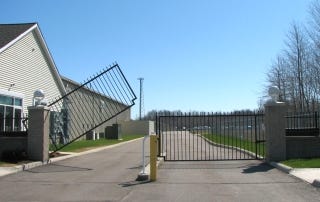There are many preventive measures a self-storage operator can take to ensure his facility’s security system runs seamlessly. Here’s how to keep your gates and gate operators, cameras, and additional security components in top condition.
June 15, 2014

By Chester A. Gilliam
As we approach summer, self-storage operators should address all the security-maintenance tasks they didn’t get to before that first winter cold snap and added to their “I’m going to fix that as soon as the weather warms up” list. That list may grow as they take a closer look at their property and see all the additional problems that have been caused by snow and ice, snow plows, and tenants over the past few months.
There are many preventive measures you can take to ensure your facility’s security system operates seamlessly. Here’s how to keep your gates and gate operators, cameras, and additional security components in top condition.
Component Checks
All security systems need some type of maintenance. This might be simply cleaning, adjusting and lubricating, or more pressing issues such as broken hinges or worn and loose parts.
 First, let’s talk about your access-control system, including gates and fencing. There are three areas to examine: chains or hinges, safety devices, and anchoring devices. Then we’ll look at cameras, and conduits and wires.
First, let’s talk about your access-control system, including gates and fencing. There are three areas to examine: chains or hinges, safety devices, and anchoring devices. Then we’ll look at cameras, and conduits and wires.
Chains or Hinges
Lubricate gate chains and hinges once per month, and replace the chain on chain-drive systems every three years.
Tighten the chain to the manufacturer’s specifications. If you don’t know the specs, a good rule of thumb is to have no more than 2 inches of drop on a gate with an opening of 18 feet.
Inspect hinges for wear and replace them if you detect any damage. This is not only an operational problem but a potential safety issue.
Safety Devices
Regularly test all safety devices, recording when they were tested and keeping a record of maintenance completed.
If your gate has a safety-edge system, regularly replace the battery in the transmitting unit.
Inspect safety loops to ensure they’re sealed and working properly.
Inspect the area of your drive where the loops are installed and reseal them if they show any signs of wear or cracking. Sealing them will keep water and foreign objects from getting into the loop wires and causing problems with your gate operation.
Anchoring Devices
Check all gate posts, fence posts and gate-operator stands to ensure they’re still safely in place. Winter freezing, thawing and refreezing can damage the concrete that holds them steady, so it may be necessary to reset them.
Check ornamental fence panels at their attachment points as well. As snow is pushed against panels, it can cause them to come unattached, which can be a safety issue.
As with the concrete and anchor bolts, posts can be damaged by chemicals and salt compounds used to melt ice and snow.
This is also a good time repaint post and fence lines that are showing signs of rust or wear.
Replace keypad stands that are leaning or bent. Inspect and correct the concrete and anchor bolts.
Cameras
Check camera-view angles, as these can be moved due to snow sliding off roofs, wind and even severe rain.
Clean the camera lens and glass, but take care to only use a mild cleaner. Never spray any cleaner directly on the camera or glass. Apply the cleaner to a soft cloth first, then gently clean the camera.
This is also be a good time to check your digital video recording system. Review footage to ensure cameras are still recording and you have enough days of video storage.
Review how to make a backup of recorded video and save it to another device. It’s better to review this now than discover you have a problem or cannot get video to save later when needed.
Conduits and Wires
Check for exposed wires and broken conduits. During the winter, metal conduits can separate, leaving wires exposed to the elements. PVC conduits will become brittle and can break or crack. If this has happened, water can get into the conduits, cause problems with your system and even create possible shock hazards.
 Schedule repairs with a qualified security specialist to ensure you’re meeting all city code requirements.
Schedule repairs with a qualified security specialist to ensure you’re meeting all city code requirements.
When Prevention Isn’t Enough
While these are just a few of the potential problems you might find during your maintenance check, all are fixable. If you don’t take care of these issues when they’re minor problems, they have the potential to become bigger headaches later. Preventive maintenance is better than emergency repairs any day.
If your security system is more than five years old, it’s time to upgrade. This includes not only cameras and keypads but gate operators. Just like everything else, these systems become obsolete and wear out. Parts become unavailable and repair costs add up. It’s better to be proactive than reactive.
You need to plan for these items in your site budget just like all other expenses. Having a security system that doesn’t work or is marginal at best is costly in time, money and tenant loss and can create liability for your business. Take pride in your site and show your customers you care by providing a quality, working security system.
Chester A. Gilliam is the owner of Wizard Works Security Systems Inc. in Castle Rock, Colo. He holds certifications in the design and installation of automated-gate systems as well as numerous certifications in video-system and access-control system design and installation. To reach him, call 303.798.5337; e-mail [email protected].
You May Also Like





